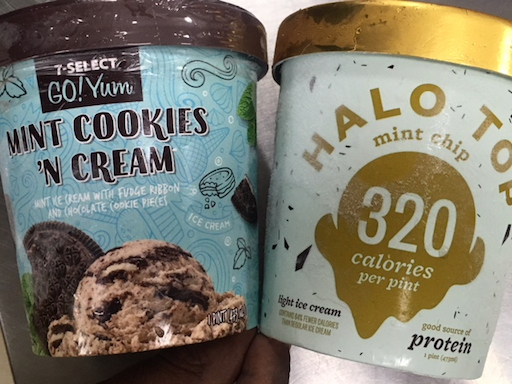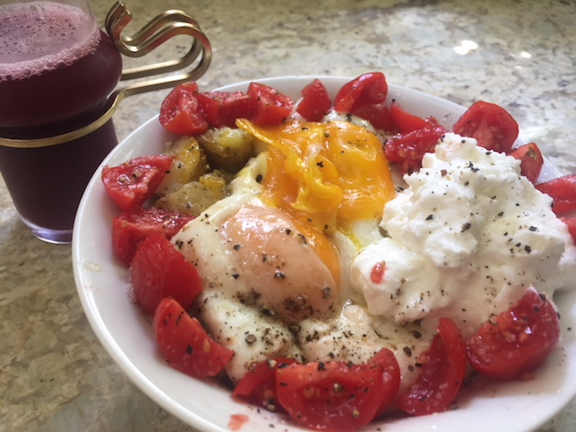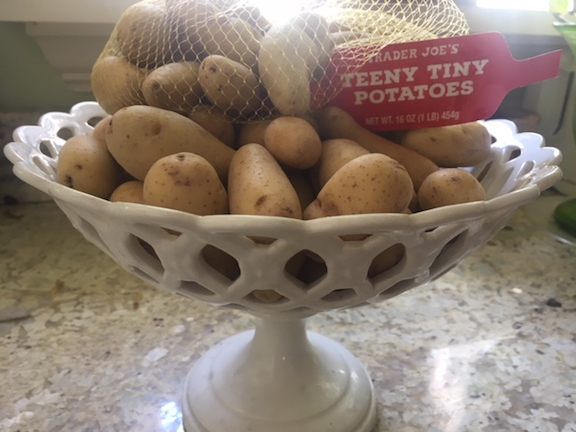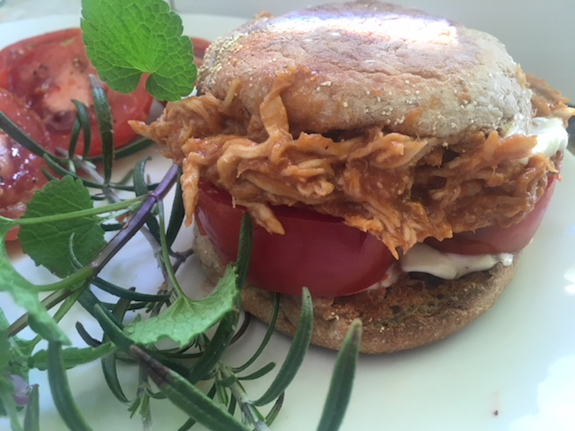Start Your Day with Nauti Foods While Exercising on the Water
- At July 15, 2018
- By Katherine
- In Articles, News
 2
2

Katherine enjoying iced coffee from Nauti Foods, the floating food truck, while kayaking on the Potomac River
Running into (literally!) the Nauti Foods floating food truck is something I look forward to when I’m kayaking or stand-up-paddle boarding on the Potomac. The experience is as surreal as it is imaginative. I couldn’t believe my eyes when I first encountered Ari selling his array of high quality, and often locally sourced delicacies – on the water.
Some selections are quite healthy such as drinkable Gazpacho in a bottle from Soup-R-Girl, or extravagant, like the ice cream sundae on top of a freshly baked bun-shaped sugar doughnut! The “Nauti Monkey” is a frozen chocolate-dipped banana. You’ll also find Dolcezza Gelato, and traditional breakfasts like bagles and cream cheese. I always get the iced coffee with half and half (yes, the real thing).
It’s the ultimate repast al fresco! Bon Appetit!
Healthy Strawberry Cheesecake Parfait – No Baking Necessary!
- At June 17, 2018
- By Katherine
- In News, Recipes
 0
0
This is an outrageously delicious dessert, especially because the main ingredient is sweet, tender, locally grown strawberries.
I tried this parfait with my Salvation Army Addiction Recovery class, where I teach how preparing and eating more fruits and vegetables can be deliciously fun. The recipes we make must be healthy, simple, inexpensive, quick, and with no cooking necessary. This was a HUGE hit!
For 10 Servings or More
Ingredients:
Use 3 medium bowls, one for each layer:
1 bowl:
Crush in Large Chunks: 9 Graham Crackers or 1-1/2 Cups Granola or Vanilla Wafers
Add Chopped Nuts, if desired
In 1 bowl, toss:
3 Cups Strawberries, sliced with hulls removed, with
1 Tablespoon Granulated Sugar
In 1 bowl, Blend, then refrigerate until set, if desired:
8 Ounces Low Fat Cream Cheese
1 Cup Nonfat Greek Yogurt
2 Tablespoons Heavy Cream
1/2 Cup Powdered Sugar
1 teaspoon Vanilla Extract
Garnish with extra strawberries, granola, and/or chopped nuts on top
Optional: Place a Sprig of Mint on Top
In a wine glass, martini glass, or clear cup, place a layer of the crushed graham crackers, a layer of the cheesecake mixture, then a layer of the strawberries. Repeat.
This recipe is adapted from “Life Made Sweeter.”
Intensely Flavored Strawberry Sherbet in 5 Minutes
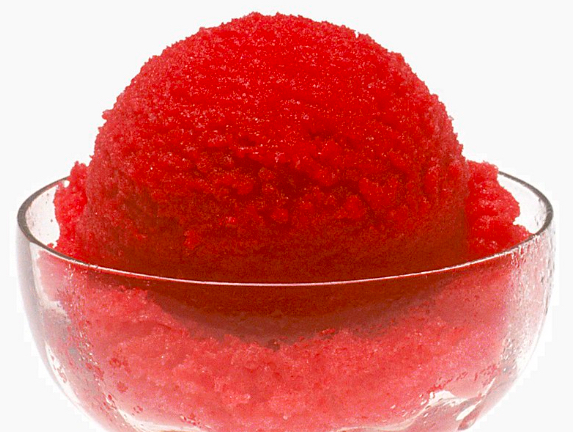
Berry Sherbet (Photo by Renee Comet, Photographer, for the National Cancer Institute – from Wikipedia.org)
5 Minutes? Yes, you heard right. Through the Salvation Army, I teach people recovering from drug and alcohol addiction – and often from the criminal justice system – the importance of including fruits and vegetables in their diets. Sound boring? It certainly could be. But not when we make recipes like this 5 Minute Strawberry Sherbet, adapted from a recipe by Kelly Senyei. It’s a sure-fire way to make anyone actually crave fruits for dessert in place of less healthy choices.
This sherbet (sherbets often contain dairy, while sorbets don’t) is luscious, creamy, and intensely flavorful. I bought the strawberries at the local Farmers Market for maximum succulence. The class hulled the berries and placed them evenly on a baking sheet. Then they (the strawberries, that is) went into the blisteringly cold Salvation Army walk-in freezer. While waiting for the berries to freeze, we reviewed a little lesson about the health benefits of strawberries. The class was especially excited hearing about strawberries’ potential for reducing inflammation, the risk for cancer, heart disease, diabetes, cognitive decline, for stimulating the immune system, and more. They learned about oxidation’s role in increasing disease, and how the more than 100 nutrients in strawberries serve as antioxidants, reducing the risk for those diseases.
I love teaching people who really need help and who benefit so much from my counseling and classes, from people with low literacy and low income, to sophisticated folks – in my classes and private practice. It is amazing how delicious food naturally attracts anyone to a healthy way of eating and living.
Here goes:
Place about 1 cup of Greek yogurt (plain or another flavor, like peach or vanilla) in a food processor. Add 8 cups of frozen strawberries, 2 Tablespoons of freshly squeezed Lemon or Orange Juice, and its zest if you like. Next, add honey or sugar to taste, about 4 to 6 Tablespoons.
Cut the recipe in half for a smaller party.
Blend in the food processor for 5 minutes straight – no peeking! And, voila… you have a rich dessert everyone will love. If you’d like to be extra fancy, serve it in a stemmed crystal glass.
A Luscious – Seemingly Sinful – Potato Dish Without Guilt for Breakfast, Lunch or Dinner
I love potatoes! Doesn’t everyone? There’s been so much potato-bashing, though, everyone seems afraid to eat them; and that’s a shame. Potatoes are filled with vitamin C, vitamin B-6, potassium, fiber, and antioxidants. Fingerlings are hard to find, but I found some to-die-for golden fingerlings at Trader Joe’s and at Farmers Markets. They have become a staple for their utter deliciousness. it’s a handy fact that they’re nutritious, too.
Their flavor is rich, buttery, and nutty. Their texture is velvety. All I do is boil the whole bag in salted water until a fork easily pierces the biggest one. I strain out the water and let them sit overnight, so they don’t get soggy. I can and eat them almost every day, wherever the mood takes me – keeping them in the frig in an air-tight container – until I run out, and boil some more.
My buttery tasting golden fingerlings with fried eggs, nonfat greek yogurt, and cherry tomatoes start with the potatoes, of course. I measure out 6 ounces (160 calories) of boiled potatoes; a surprisingly large amount, I’m happy to say.
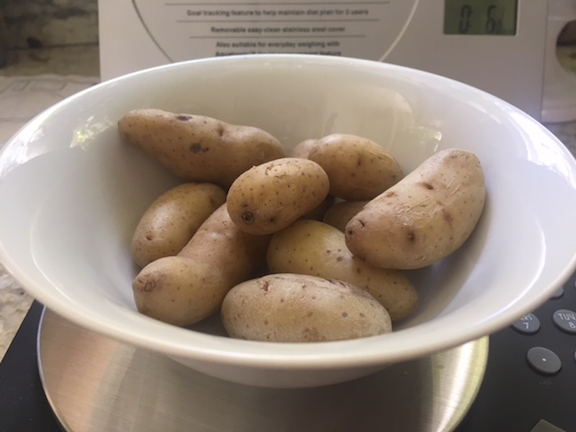
Then I quickly fry the eggs in a teaspoon or two of canola oil in a non-stick pan. I prefer them over-easy. I sprinkle with freshly ground pepper and a bit of kosher salt.
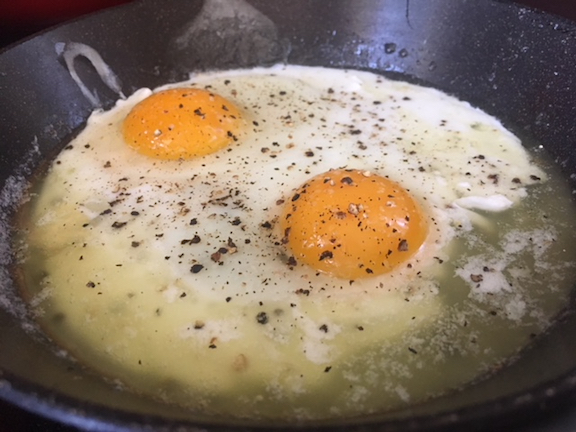
I plop the eggs atop the potatoes. I add quartered, fresh cherry tomatoes, and a dollop of plain, nonfat Greek yogurt (my favorite is Fage) on the side – and to me, it tastes like I’ve just smothered my potatoes in butter and sour cream. Wonderfully sinful. I add chopped cherry tomatoes for color, a glass of juice. And I have the PERFECT meal! It never fails to please…
The simple things in life are often the best. Don’t you agree?
Tai Chi’s Breathtaking & Bewildering Body & Brain Benefits
- At April 16, 2018
- By Katherine
- In Articles, News
 0
0

Katherine starts many of her “Nutrition, Health & Wellness” classes with Tai Chi (Photo by Brooks Grant, BGrant Photography)
When a study found tai chi increased bone mass and muscle strength, I had to learn more. Was everything scientifically established so far about improving bone and muscle unnecessary? No protein? No impactful exercise? No Calcium or Vitamin D? No hormone changes or medications? How could this easy, gentle series of martial arts movements – involving none of these factors – improve muscle and bone?
Tai Chi, a Chinese martial art, is a centuries-old mind and body practice. Tai chi is a combination of movement, breathing, attention, visualization, and rich psychosocial interactions with teachers and other students, according to Harvard Magazine. It is so easy and gentle, anyone can do it. Yet its benefits are vast; some so impressive – even counterintuitive – I had to research the science to believe it. After reviewing the studies, I’ve added tai chi to the all-encompassing arsenal of my health-boosting behavior-change programs.
In one of its publications, Harvard calls Tai Chi, known as “meditation in motion,” “medication in motion.” Tai Chi provides a host of benefits, including…
- Increasing bone and muscle health: After 12 weeks of Tai Chi, postmenopausal, osteopenic women experienced improved muscular strength and increased bone health. Tai chi apparently reduces the natural age-related oxidative damage that causes bone and muscle breakdown. The results were even stronger when the subjects drank green tea (assuming other age-related changes such as gray hair and wrinkles, too),
- Increasing balance and stability in older people, leading to decreased falling (in one study, a forty percent reduction) and fear of falling, even helping people with mild to moderate Parkinson’s Disease,
- Reducing pain caused by knee osteoarthritis, fibromyalgia, back pain, and perhaps neck pain,
- Enhancing ability to reason, plan, remember, and solve problems in older people, even those showng signs of mild cognitive impairment and dementia,
- Improving quality of life and mood in people with heart failure, and improved ability to exercise in people who experienced a heart attack, thus an effective cardiac rehabilitation technique,
- Increasing immune response, improving life for people with chronic health problems,
- Reducing stress and its inflammatory response.
I start many of my “Nutrition, Health and Wellness” classes with Tai Chi. In the photo above, I’m leading a community class sponsored by AmeriHealth Caritas DC, hosted by Lyndia Grant of Lyndia Grant and Associates, LLC held at Trinity College in NE Washington, DC.
13 Surprising, Simple & Powerful “Foods As Medicine” You Should Try
- At March 21, 2018
- By Katherine
- In Articles, News
 0
0
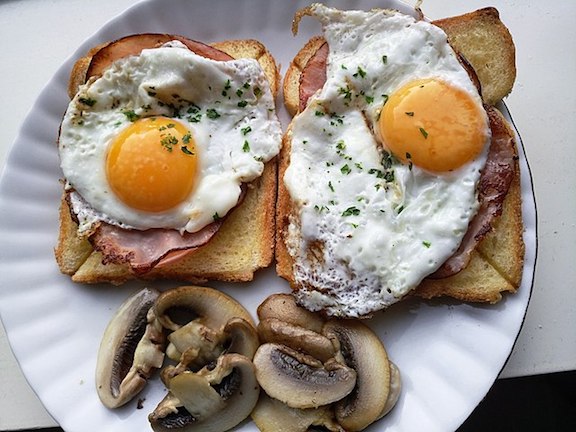
A responsibility I take very seriously – and one I avidly enjoy – is discovering the best nutrition therapy, or “Foods as Medicine,” for each of my clients’ unique life enhancing, healing needs, and even for improving some rare conditions. Over the years, I’ve come across some very simple, strange, and powerful solutions which have been successful and ones from which you might benefit.
Tea for increasing bone and muscle strength: Studies are finding that regular tea drinking may reduce age-related inflammation and oxidation causing muscle and bone breakdown resulting in increased bone mass and muscular strength.
Green Tea for speedier weight loss: Certain compounds in tea, and especially green tea, have been found to burn body fat. Caffeine slightly increases fat-burning, but the combination of caffeine and green tea catechins [a type of flavonoid] is even more effective.
Chocolate improves erectile dysfunction: The flavanols in cocoa help maintain a healthy vascular system, relax blood vessels, reduce blood clotting, oxidative damage, and improve blood flow – to every part of the body.
Chocolate reduces wrinkles: After drinking cocoa for 24 weeks, women experienced reduced wrinkles and increased skin elasticity, reducing the effects of sun damage and aging.
Mushrooms boost the immune system, improving diseases from colds to cancer. Used medicinally since at least 3,000 BCE, mushrooms appear to increase the effects of chemotherapy, and lengthen survival of cancer patients. Mushrooms, considered “pre-biotics,” enhance the digestive tract’s healthy bacteria, the “microbiome,” thus providing your body with extra disease-fighting properties.
Mushrooms reduce fatigue: They act on the muscular system, the body antioxidant system, cardiovascular system, hormone system, and immune system, all of which improve liver function, blood circulation, and blood glucose regulation, among other benefits.
Tart cherries (dried or concentrated) and tart cherry juice reduce pain from gout and neuropathy, improve muscle recovery after intense exercise, and enhance sleep quality: Scientists hypothesize that the presence of hundreds of compounds – especially anthocyanins – in cherries are responsible for the benefits. But there are probably as yet undiscovered properties which contribute to their health strengthening qualities.
Hydrolyzed Collagen reverses the pain of arthritis, the aging of joints, bones, muscles, skin, and reduces cellulite. Collagen is the most abundant protein in the animal kingdom important for joints, bones and skin. Taken as a supplement, collagen needs to be “hydrolyzed” into tinier molecules called “collagen peptides” so it can effectively enter your body’s cells and your body can utilize it.
Coffee extends exercise performance: Once banned by the International Olympic Committee, caffeine stimulates the neuromuscular system to increase your body’s ability to exercise longer, with less fatigue, than it would absent caffeine.
Yogurt reduces body fat: The probiotic cultures in yogurt have been found to prevent insulin resistance, diabetes, and body fat. People who eat yogurt are leaner than those who eschew.
Egg yolks reduce cataracts and macular degeneration, the leading cause of blindness: Egg yolks contain compounds called lutein and zeaxanthin, also found in deep leafy greens. But they’re more powerful in egg yolks because lutein and zeaxanthin need to be eaten with fat, found in egg yolks (but not in greens), to be effective.
Beans clear acne and improve skin: There is strong evidence that a diet with foods causing the lowest blood sugar responses (a low glycemic diet) may be the best solution for clear skin. Beans are not only nutritious, but are very low on the glycemic index scale.
Extra Virgin Olive Oil – but ONLY when newly harvested – reduces metabolic syndrome: The nutrients in olive oil, polyphenols, responsible for its superior health benefits, disappear with time, light, and heat exposure. But when high in polyphenols, for instance, the first six months after harvest, EVOO “turns on” several genes which lower blood glucose, blood cholesterol and blood pressure,
Salmon reduces Alzheimer’s Disease (AD): Studies show inflammation is a major cause of AD and cognitive decline. Omega-3-Fatty Acids, which salmon contains in abundance, have proven abilities to reduce inflammation.
Nuts for weight loss: Even though nuts are quite caloric, people eating nuts are more likely to have lower body weights. Nuts are satiating; they make us feel full. Adding nuts to meals, especially breakfast, decreases overall calorie intake, making weight loss easier.
Potatoes have sustained many cultures for thousands of years. Think Russia, Scandinavia, Ireland, South America. Without potatoes, Vitamin C deficiency would have flourished. Especially in northern climates where citrus fruit and many other high vitamin C fruits and vegetables cannot be grown. They have an undeserved bad rap! They’re filled with fiber, potassium, Vitamin B-6, some iron, and – believe it or not – they are low calorie for a starchy food, only 110 calories for 5.3 ounces. Eaten plain, the concern is real, though. as they raise blood glucose quite high. But eaten with fat such as when they are sautéd or roasted in oil, eaten with a proten, such as salmon or chicken, even Greek yogurt instead of sour cream, as they would be in a meal, those foods will lower the blood sugar response (glycemic index) to much lower levels.
Enjoy!
Processed Food? You’d Be Surprised How Delish!
While making meals from scratch has been the paragon of nutritional virtue, it is increasingly unrealistic for most people in our crazy busy lives to even contemplate. And while processed, pre-prepared, packaged, frozen, vacuum packed, and even canned options seem like an abomination to many of you, they can be more nutritious – and many times quite yummy – for a fraction of the cost of a restaurant meal.
I’ve always enjoyed BBQ, but have never quite gotten the hang of making a really delicious one. The best BBQ I’ve ever had was in Texas – and it took days to make! BBQ in restaurants I’ve found too greasy, filling, and expensive. But I recently discovered a pre-packaged one in a local grocery store’s refrigerator section that is mouthwatering. For only 200 calories in a 1/2 cup serving – it is perfect for me (and, of course, most men could have twice that much). Try it yourself!
Reverse Winter Bloat and Blues!
- At March 05, 2018
- By Katherine
- In Articles, News
 0
0
Are you experiencing the winter blues? Bloat? More cravings than usual? It seems these occurances are running rampant right now. January and February are tough months for many people nation-wide.
The most probable causes are in your control and involve decreases in both sunlight and physical activity. Together, they can contribute to the blues and enough of a calorie imbalance to cause weight gain. Here’s how.
- Sunlight. Some people are particularly susceptible to light deprivation, caused by the decrease in daylight hours during the winter. This affects the neurochemical serotonin, responsible for your mood and appetite, prompting increased food cravings and weight gain.
- Physical Activity. When it’s cold outside, we’re less physically active and cut back on subtle calorie-burning activities such as short walks and light outdoor chores. These caloric expenditures may only add up to about 100 calories per day, but this translates into a 3-4 pound weight gain (or more) during the winter months.
What to do to both improve your mood and curb your cravings?
- Increase exposure to sunlight. Bundle up and go outside to reverse the symptoms of light deprivation. You’ll feel refreshed and less bored, and your appetite may be more controllable. The amount of needed daylight varies for each individual. In general, the more the better. One hour daily in the morning, ideally at sunrise, is most helpful. If you’re not an early bird, several hours on the weekends may help make up for a lack of sun during the week. Some people may benefit from getting daily “light therapy” which would be prescribed by your doctor. Some popular products are from “sunbox.”
- Up your activity level, even just a little. During just one exercise bout, your brain releases feel-good chemicals, called endorphins into your body. These chemicals reduce pain, increase feelings of well-being and elevate your mood. If you’re regularly active, these benefits multiply. A brisk 30-minute walk just three times a week relieves major depression just as effectively as an antidepressant in most adults, according to a study published in the Archives of Internal Medicine. Wear a pedometer to keep track of your activity level and to motivate you to get more.
- Increase your intake of a colorful array of fruits and vegetables. These low-cal but filling carbohydrates increase serotonin production, helping to regulate mood and appetite. They also help you feel more satisfied for fewer calories, and research shows adding them to a meal could save at least 100 calories (translating to 4 – 5 pounds during the colder months)…some tips:
- To lower the calories and increase the portion size of a favorite recipe, pump up the volume by adding vegetables as often as you can. This way, you can eat your usual portion for fewer calories.
- Choose fresh fruits over dried fruits or juices. For 100 calories, you could eat 1/4 cup of raisins or two cups of grapes. (You’re more likely to fill up on the grapes.)
- Start lunch or dinner with a hearty, satisfying and yummy bowl of soup or a large and colorful vegetable salad with a delicious vinaigrette.
- Turn main courses into soups or salads by adding broth or vegetables.
The Vitamin Supplement Everyone Should Be Taking
- At February 26, 2018
- By Katherine
- In Articles, News
 0
0
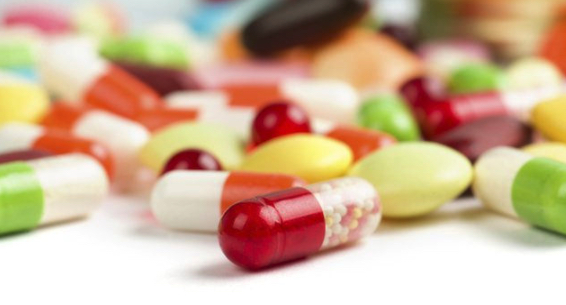
My philosophy has always been to get your nutrients from food, not vitamin supplements. I base my advice on the body of scientific evidence finding significant negative effects, or no effects – of vitamin and antioxidant supplementation (starting with a gound-breaking study published in the New England Journal of Medicine finding antioxidant supplements had such negative effects on the subjects, it had to be halted early). Accordingly, nutrition professionals are cautious before making recommendations, as they should be. In fact, one way to smoke out a “quack nutritonist” – someone unqualified to practice nutrition – is learning that they’re selling supplements.
That’s not to say that some supplements aren’t useful. When personalized to fit your needs, some may be beneficial – even critical – for your health. Nonetheless, taking supplements cannot substitute for the benefits of eating the nutrients in food … except for one.
The need for this supplement started revealing itself a couple of decades ago. Children, and some adults, began exibiting symptoms of a life-threatening deficiency disease, one we virtually hadn’t seen since the turn of the 20th century, when 60 to 80 percent of children suffered from it. Subsequently, the disease was mostly iradicated by supplementing food. Nutritionists determined what was needed in the food supply based on lifesyle and consumption patterns in that era, and this calculation prevented the defiency disease … until now.
Why is food supplementation no longer working? Modern technology, changes in food consumption patterns and in lifestyles. These same changes in American life have created many health discoveries. Sometimes you don’t know the value of something until it’s missing! Not only have we experienced an outbreak of the deficiency disease, we uncovered many more negative effects of its inadequacy, and thus, reasons why this nutrient is paramount to health.
Vitamin D is a nutrient taken for granted for millions of years because we got enough of it naturally from the sun. But increasingly, Americans are not exposed to sunshine. We spend most of our time indoors on our computers or in our cars. When we venture outside we’re using sunscreen, which blocks not only harmful ultraviolet (UV) rays which cause skin cancer, but also prevents the skin from absorbing the UV rays necessary for producing Vitamin D in our bodies.
Vitamin D deficiency has caused unexpected consequences. It is a hormone present in almost all of your cells. Its effects are vast. We learned definitively in the early 20th century that its deficiency causes soft bones (rickets) which literally bow a child’s legs because they can’t hold up his/her weight. Further, new research is finding its deficiency may increase your risk for autoimmune diseases such as diabetes, also cancers, heart disease, infectious diseases, schizophrenia, multiple sclerosis, Parkinson’s disease. You get the picture… It’s a big deal!
Because there is very little in food, adding 100 IUs of vitamin D to a cup of milk since the 1930s has prevented rickets successfully until today’s lifestyles changed the predicted amount of sun exposure and milk consumed. And because vitamin D deficiencies seemingly vanished, we were unaware of how contributory it was to health.
The prevailing National Academy of Sciences Food and Nutrition Board recommendation for vitamin D has been 400 IUs daily. Today, it’s unclear how much vitamin D each person needs to take because of variable sun exposure. But there seems to be a consensus among vitamin D scientists that blood values should be at least 50 ng/mL and there seems to be no benefit of going higher than 75 ng/mL (though most medical labs consider 30 as adequate). My clients take anywhere from 1,000 IUs to 4,000 IUs (the safe upper limit – UL) daily to achieve 50 ng/mL. Recommendations for sun exposure vary, but in general, it’s been recommended that careful exposure of the hands, arms and face 2 to 3 times a week for 15 minutes is probably sufficient (Res Medica, Volume 268, Issue 2, 2005). But talk to your doctor about your individual needs.
Vitamin D, a fat soluble vitamin which is stored in your body, can be toxic when too much supplement is taken. Though, natural sources in food and from the sun cannot cause overdoses. In Europe in the 1950s, cases of soft tissue, heart and brain calcification, leading to mental retardation and other birth defects, were discovered to have been caused by excessive vitamin D added to the food supply. Ergo, supplementation has since been removed or scaled back in Europe.
Just like all nutrients, it’s important not to get too little – or too much. I call it the “Goldilocks effect,” because it needs to be “just right!”



